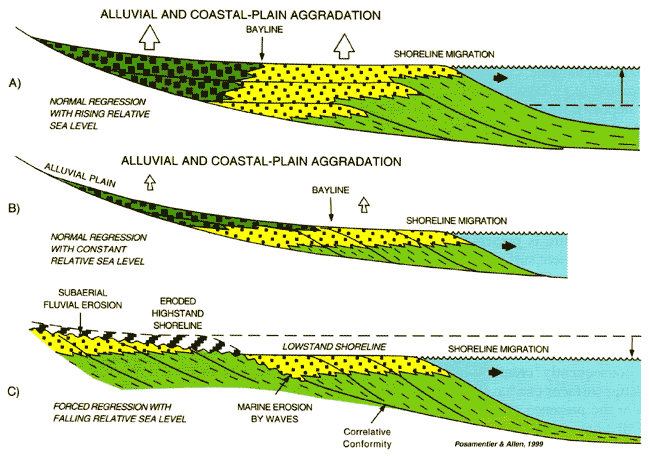|
aggradation
base level
correlative conformity
forced regression
lowstand systems tract
retrogradation
transgression



|
regressions are defined as either normal or forced.
normal regression: regression of the shoreline driven by sediment supply, during a time of base-level rise at the shoreline (Posamentier, & Allen, 1999; Catuneanu, 2002). The necessary condition for normal regressions to occur is that sedimentation rates must outpace the rates of base-level rise at the shoreline. In a most complete scenario, two normal regressions are expected during a full cycle of base-level changes: a lowstand normal regression following the onset of base-level rise (early stage of base-level rise), and a highstand normal regression during the late stage of base-level rise (Posamentier, & Allen, 1999; Catuneanu, 2002). Normal regressive deposits display a combination of progradational and aggradational depositional trends (Posamentier, & Allen, 1999; Catuneanu, 2002).
forced regression: regression of the shoreline driven by base-level fall. Forced regressive deposits display diagnostic progradational and downstepping stacking patterns (Posamentier, & Allen, 1999; Catuneanu, 2002).

A seaward movement of the shoreline indicated by seaward migration of the littoral facies (Mitchum, 1977).
References
Catuneanu, Octavian (2002), Sequence stratigraphy of clastic systems: concepts, merits, and pitfalls Journal of African Earth Sciences, Volume 35, Issue 1, Pages 1-43
Mitchum Jr., R. M., (1977), Seismic stratigraphy and Global Changes of Sea Level: Part 11. Glossary of Terms used in Seismic stratigraphy: Section 2. Application of Seismic Reflection Configuration to Stratigraphic Interpretation, Memoir 26 Pages 205 - 212.
Posamentier, H.W., Allen, G.P., 1999. Siliciclastic sequence stratigraphy: concepts and applications. SEPM Concepts in Sedimentology and Paleontology no. 7, 210 p
|